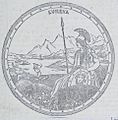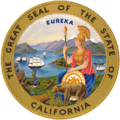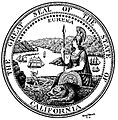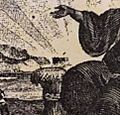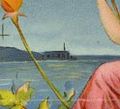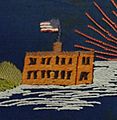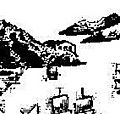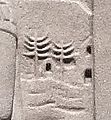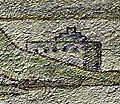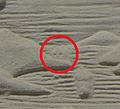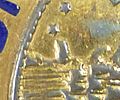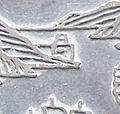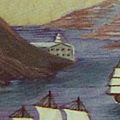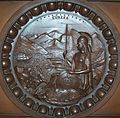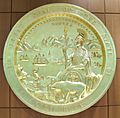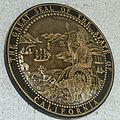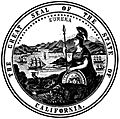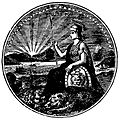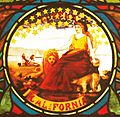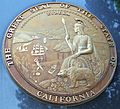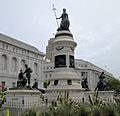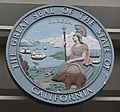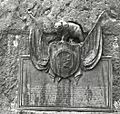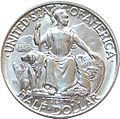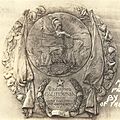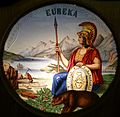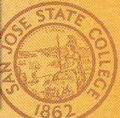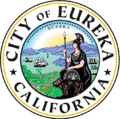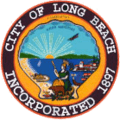
The Great Seal of California.
The Great Seal of California is the official symbol of the state of California. It was first chosen in 1849 when California was becoming a state. Since then, it has had only a few small changes. The last change was made in 1937.
The seal shows many important things about California. You can see the Roman goddess Minerva, who represents wisdom. The word Eureka is also there, which is California's state motto. It means "I have found it!" A California grizzly bear is on the seal too, showing the state's wildlife.
What is the Great Seal of California?
The Great Seal of California is like a special badge for the state. It's used on official documents and buildings. It helps people know that something is from the California state government. It was adopted at the first California Constitutional Convention in 1849. This was when leaders met to create the rules for the new state.
Why is the Seal Important?
The seal is a very important symbol. It shows the history and values of California. When you see the seal, you know it represents the whole state. It is used on laws, official papers, and even on the Governor's office.
What Do the Symbols Mean?
Each part of the Great Seal has a special meaning. These symbols tell a story about California.
Minerva: Goddess of Wisdom
The goddess Minerva is a main figure on the seal. She is a Roman goddess of wisdom, war, and crafts. On the seal, she represents California being born as a state. She is shown fully grown and ready for battle. This means California became a state without having to go through a long period as a territory.
The Grizzly Bear: California's Strength
A California grizzly bear is shown next to a cluster of grapes. The grizzly bear is a symbol of California's strength and wildlife. It used to be very common in the state. The grapes show the state's agriculture and wine industry.
The Word "Eureka": I Have Found It!
The word Eureka is California's state motto. It means "I have found it!" This word was chosen because of the discovery of gold in California. Many people came to the state hoping to find gold and a new life.
Other Important Symbols
- Wheat and Mining: You can see bundles of wheat and a miner working with a pickaxe and shovel. These represent California's rich agriculture and its history of gold mining.
- Ships and Rivers: Ships are sailing on the Sacramento River. This shows California's strong trade and commerce. The river is important for transportation.
- Mountains: The Sierra Nevada mountains are in the background. They represent the state's beautiful natural landscape and its resources.
- Stars: There are 31 stars around the edge of the seal. This number represents California as the 31st state to join the United States.
History of the Seal
The design of the Great Seal was first created in 1849. It was approved by the people at the Constitutional Convention. Over the years, there have been small changes to the seal.
Early Designs
The first design was made by a man named Robert S. Garnett. It was then drawn by Caleb Lyon. The seal has always included the main symbols like Minerva, the bear, and the word "Eureka."
Changes Over Time
The seal has been updated a few times to make it clearer or to fix small details. The last official change was in 1937. This update made sure the seal looked the same every time it was used. Even with these changes, the main message and symbols of the seal have stayed the same.
Images for kids
-
California historical coat of arms (illustrated, 1876)
-
1849 illustration of the Seal of California that accompanied Bayard Taylor's description
-
Modern day full-color illustration of the Seal of California
-
Marc J. Rowe's interpretation of the Seal of California
-
An interpretation of the steamship as a sidewheeler
-
An interpretation of the steamship as a screw steamer
-
A circa 1888 image of Fort Point for comparison with representations of the fort on the following renditions of the Seal of California
-
An 1875 image from a sample book by San Francisco lithographer Grafton Tyler Brown
-
California State Letterhead (1886): Printed by a San Francisco lithographer
-
James Lick Pioneer Monument, San Francisco (1894)
-
So-called Dollar HK-249: Issued for the 1894 Midwinter Fair held in San Francisco. Notice the lighthouse and flagpole which appear in the circa 1888 image of the actual fort.
-
1895 cigar box label from an Oakland manufacturer
-
Spanish–American War flag at the California State Archives, Sacramento (c. 1898): Given to American soldiers on their way to the Philippines via the Presidio in San Francisco
-
California Blue Book (1895). The building is identical here to the way it appears in the 1937 standardized seal.
-
Ronald Reagan State Building, Los Angeles (1939)
-
On the west steps of the California State Capitol, Sacramento (1952)
-
-
Veteran's Welfare Bond (1925): Here the building looks somewhat like the old State Capitol in Benicia.
-
-
Room 500, Library and Courts I, Sacramento (c. 1928)
-
Marc J. Rowe's redesign (1928)
-
Berkeley Veterans Memorial Building (1928)
-
Division of Motor Vehicles inspector's badge (c. 1921–1931) in the collection of the CHP Museum in West Sacramento
-
The reproduction of the medal the Los Angeles-based Helms Bakery won in 1934, showing a building that looks like the Los Angeles Harbor Light, which may explain the location of the structure on an island, away from its usual spot on the mainland, similar to the light house
-
Lucile Lloyd Mural in Room 4203, California State Capitol, Sacramento (1937)
-
East Entrance, California State Capitol, Sacramento (1950): Here in the O. C. Malmquist panels, the building takes on more of a Spanish mission look, exchanging the dome for a similarly-shaped curved roof line.
-
State Personnel Board, Sacramento (1954): After more than fifty years, is this interpretation meant to be a return to Fort Point? Despite the difference in design from the previous image, this seal was also created by O. C. Malmquist.
-
California State Archives, Sacramento (c. 1956): Another possible throwback to Fort Point?
-
1304 O Street, Sacramento (1960): Many seals found on state buildings from approximately 1960-1980 do not show the building, which might explain why the 1967 official color scheme makes no mention of it.
-
California State Archives, Sacramento (1966): Artist Mrs. Pine L. Eisfeller used 87,000 tiny beads to create this seal.
-
Elihu M. Harris State Building, Oakland (1998): Although this example is from twenty years later, this style of building had been in use as early as 1978.
-
Vietnam Memorial, Capitol Park, Sacramento (1988)
-
Family Law Court, downtown Riverside (1998): The artist of this seal may have based his interpretation of the building on the Peace Tower found on Mount Rubidoux, a local Riverside landmark.
-
Hiram Johnson State Building, San Francisco (c. 1998): The building on this seal, in the building's auditorium, looks somewhat like one of the city's famous painted ladies Victorian homes.
-
Governor's Office Reception Area Carpet, California State Capitol, Sacramento (c. 1999)
-
CalTrans District 7 HQ, Los Angeles (2004): Another unusual interpretation
-
B. F. Sisk Courthouse, Fresno (c. 2010)
-
DMV, First Avenue, Sacramento (Present day two-tone)
-
Department of Education, Sacramento (Present day full color): The building has taken on more of a tower rather than a dome.
-
Thirteen star seal, Senate Secretary's Desk, California State Capitol, Sacramento
-
Twenty-one star seal, Stanley Mosk Library and Courts Building, Sacramento
-
Twenty-six star seal, Hiram Johnson State Building auditorium, San Francisco
-
Twenty-nine star California Governor's Seal, which should have thirty-one, as the state seal does, California State Capitol, Sacramento
-
Twenty-nine star seal on the reverse of a Series 1882BB National Bank Note
-
Twenty-nine star seal on the B.F. Sisk Courthouse in Fresno
-
Thirty-two star seal, 1895 California Blue Book, page 299
-
-
Thirty-eight star seal, 1895 California Blue Book, title page
-
Thirty-eight star seal, 1889 San Diego County courthouse
-
1908 "sky" light seal in the California State Capitol
-
1964 seal (one of two) on display at the Resources Agency Building
-
The James W. Marshall monument in Coloma
-
Minerva stands atop the James Lick Pioneer Monument in San Francisco
-
The very large seal at the CPUC building in San Francisco
-
At the base of the 1846 Bear Flag Revolt monument in Sonoma
-
Seal at the Circle of Palms Plaza in San Jose
-
A state seal is featured among the six seen here at the Los Angeles County Law Library
-
From the Helms Bakery building in Culver City
-
From the Family Law Court in downtown Riverside
-
In front of the old San Diego Central Public Library
-
1915 seal on the California Building in Balboa Park, San Diego
-
Obverse of 1936 California Pacific International Exposition Commemorative Half-Dollar
-
From a tablet presented to the cruiser California by the Native Daughters of the Golden West in 1907
-
J.W. Hansen's artistic rendition of the seal at Hoover Dam's Dedication Plaza
-
A blueprint of the seal in the Decatur House in Washington, D.C.
-
1857 seal once located in the ceiling of the U.S. House of Representatives
-
1897 seal in the Library of Congress
-
The seal can be seen carved into the floor of the temple area of the Manila American Cemetery and Memorial in the Philippines
-
San Jose State University's historic Seal, from its days as a California State College
-
Seal of the City of Eureka
-
Seal of the City of Long Beach
-
Seal of the County of Alpine
See also
 In Spanish: Gran sello del estado de California para niños
In Spanish: Gran sello del estado de California para niños
 In Spanish: Gran sello del estado de California para niños
In Spanish: Gran sello del estado de California para niños



